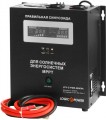Maximum efficiency
Inverter efficiency for solar panels.
The efficiency indicator is the percentage ratio between the amount of energy that the device delivers to the load and the energy consumed from the solar panel. The higher this parameter, the more efficient the operation of the device and the lower the losses during conversion. In modern inverters for solar panels, efficiency values of up to 90% are considered average, and above 90% are considered good.
Rated power
The rated output power of the inverter, expressed in volt-amperes (VA). Essentially, this value is equivalent to power in watts (W).
This parameter refers to the power that the device can continuously deliver to consumers. When choosing based on this parameter, ensure that the rated power of the inverter exceeds the expected load power by approximately 15-20%. Additionally, keep in mind that some electrical appliances (particularly those with electric motors, such as vacuum cleaners, refrigerators, etc.) consume significantly more energy at startup than during regular operation. For such loads, it's important to check the peak power of the inverter (see the relevant paragraph) — it should be higher than the starting power of the load.
Rated power
The rated output power of the inverter, expressed in watts (W).
This parameter means the power that the device can provide to consumers for an unlimited time. It is necessary to choose according to this indicator so that the rated power of the inverter covers the power consumption of the expected load by approximately 15-20%. It is also worth considering that some electrical appliances (in particular, units with electric motors - vacuum cleaners, refrigerators, etc.) consume significantly more energy when starting up than after entering the mode. For such a load, it is also necessary to clarify the peak power of the inverter (see the corresponding paragraph) - it should be higher than the starting power of the load.
Peak power
The highest total output power in watts (W) that the inverter can deliver to a load for a relatively short period of time, on the order of 2 to 3 seconds. As a rule, this power is 30 - 50% more than the rated power (see above). The peak load value can be useful when calculating how the inverter works together with appliances that consume a lot of energy at start-up (vacuum cleaners, borehole pumps, power tools, etc.). The rule here is simple - the peak power of the inverter must not be lower than the starting power of the load.
Number of sockets
The number of standard 230 V sockets provided in the inverter design.
The more
sockets there are, the more electrical appliances can be connected to the inverter at once. At the same time, the specificity of using inverters is such that they rarely have to be used for several devices at once. In addition, simultaneous connection requires appropriate power (see “Rated output power”), and the sockets themselves also significantly affect the dimensions. Therefore, most often in modern home inverters one socket is used – this, usually, is enough. However, high-quality powerful inverters can have two sockets.
Number of battery inputs
Number of points for connecting batteries to the inverter. Household models usually have one such input, while powerful and productive models may have two or even three battery inputs. Multiple inputs allow the system to be scaled by adding batteries without having to replace the inverter.
Maximum charge current
The maximum amount of direct current in amperes that the inverter can convert. If the solar panel produces a current exceeding this value, the inverter simply does not use it. This is often justified when connecting an inverter to high-power solar panels - the maximum input current of the inverter is reduced to acceptable values so that moderate-sized wires can be used to transmit energy.
Operating voltage PV
The operating range of the inverter is usually located between the starting voltage and the maximum voltage. This interval is indicated in volts.
Functions
—
UPS function. Inverters with a UPS function automatically switch to battery-powered mode when there is insufficient power generation from solar panels or in cases where the main power source is disconnected. This ensures load redundancy. Note that switching may not occur instantly, but with a certain delay (about 10-30 ms).
—
Connecting the generator. Inverters that support the generator connection function significantly increase the reliability and efficiency of autonomous solar energy systems. In practice, the function can be implemented in several basic ways. First, the system can automatically turn the generator on and off depending on the battery charge level or current power consumption, ensuring efficient use of resources and minimizing fuel consumption. Secondly, switching the load to the generator can be carried out when there is a shortage of electricity generation from solar panels. And thirdly, the generator can be used to maintain an optimal battery charge level so that the system is in full readiness at any time.
—
Parallel connection. The inverter has special connectors through which two or more devices can be connected to a single electrical network. Parallel connection is used when one inverter is not able to pull the entire load from solar panels and the input power exceeds the capabilities of the device itself.
—
Built-in monitoring. The presence of a built-in monitoring module on board the inverter, which collects information about the productivity of solar panels, allows you to monitor energy production and consumption, as well as monitor the performance of the system as a whole. Moreover, these parameters can often be viewed and controlled in real time (including through a mobile application for a smartphone). The monitoring module is usually connected to the Internet via a Wi-Fi network.

